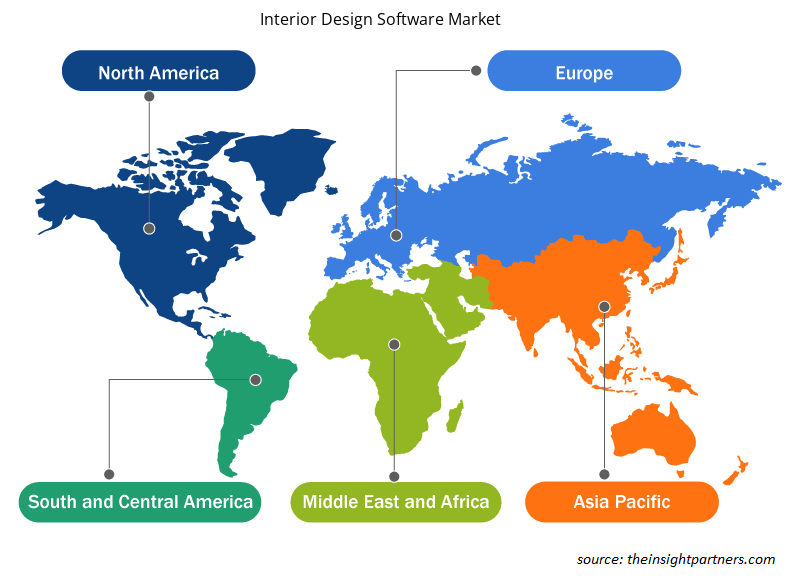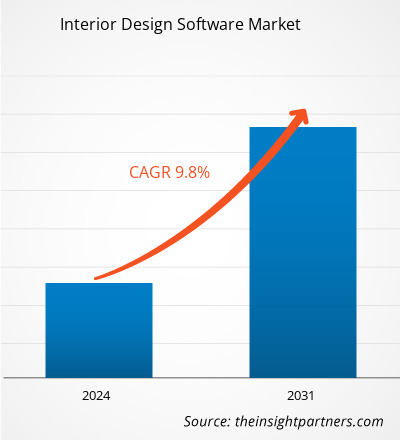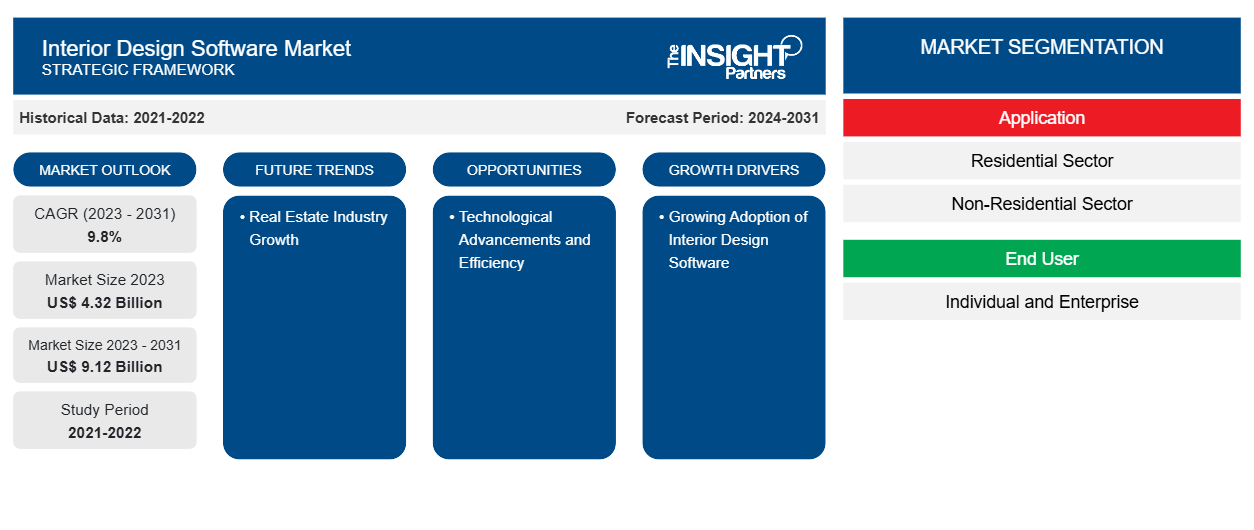Der Markt für Innenarchitektursoftware soll von 4,32 Milliarden US-Dollar im Jahr 2023 auf 9,12 Milliarden US-Dollar im Jahr 2031 anwachsen. Der Markt wird zwischen 2023 und 2031 voraussichtlich eine durchschnittliche jährliche Wachstumsrate (CAGR) von 9,8 % verzeichnen. Das Wachstum der Immobilienbranche dürfte ein wichtiger Trend auf dem Markt bleiben.
Marktanalyse für Innenarchitektur-Software
Die steigende Nachfrage nach mehr Produktivität ist einer der Hauptfaktoren, die diesen Markt antreiben. Auch die steigende Nachfrage nach besserer Innenarchitektur und Dekoration und die zunehmende Nutzung von Cloud-basierter Software kurbeln das Wachstum des Marktes an. Interoperabilitätsprobleme im Zusammenhang mit Innenarchitektursoftware schränken das Wachstum dieses Marktes ein. Darüber hinaus wird erwartet, dass das Wachstum des Virtualisierungsprozesses und die Nachfrage nach Innenarchitektursoftware, die in Ländern wie China schnell wächst, dem Markt zahlreiche Chancen bieten.
Marktübersicht für Innenarchitektur-Software
Mit der Innenarchitektur-Software können Architekten die Qualität der Innenumgebung frühzeitig einschätzen. Die Architekten können diese Software auch verwenden, um Abweichungen des geplanten Gebäudes von den erforderlichen Kriterien zu identifizieren, zu verfolgen und zu messen. Diese Software ermöglicht es Architekten außerdem, vorbeugende Maßnahmen zu ergreifen, um den Renovierungs- und Umbaubedarf zu verringern. Sie verfügt außerdem über eine umfassende Sammlung von Optionen, wie z. B. Designs für Fenster , Türen, Betten und Tische, mit denen ein Designer ein genaues Modell des Raums erstellen kann.
Passen Sie diesen Bericht Ihren Anforderungen an
Sie erhalten kostenlose Anpassungen an jedem Bericht, einschließlich Teilen dieses Berichts oder einer Analyse auf Länderebene, eines Excel-Datenpakets sowie tolle Angebote und Rabatte für Start-ups und Universitäten.
-
Holen Sie sich die wichtigsten Markttrends aus diesem Bericht.Dieses KOSTENLOSE Beispiel umfasst eine Datenanalyse von Markttrends bis hin zu Schätzungen und Prognosen.
Treiber und Chancen auf dem Markt für Innenarchitektur-Software
Zunehmende Nutzung von Innenarchitektur-Software
Ein wichtiger Wachstumstreiber für den Markt für Innenarchitektursoftware ist die zunehmende Nutzung dieser Software durch Architekten, Ingenieure und Bauunternehmer. Sie leistet einen wesentlichen Beitrag in den frühen Entwurfsphasen zur Beurteilung der Innenausstattung. Sie reduziert Fehler, ermöglicht ein effektives Zeitmanagement und zeigt alle Unterschiede zwischen einem vorgeschlagenen Entwurf und der tatsächlichen Ausführung auf. Dadurch wird die Gesamteffizienz und Genauigkeit der Arbeit verbessert, indem Grundrisse, Möbel und Innendekorationen in eine realistische, dreidimensionale Umgebung eingefügt werden.
Technologischer Fortschritt und Effizienz
Der plötzliche Anstieg der weltweiten Bautätigkeiten, der zeitgleich mit der breiten Einführung von Innenarchitektursoftware zur Verbesserung der Betriebseffizienz erfolgte, beschleunigt das Wachstum im Bereich der Innenarchitekturdienstleistungen enorm. Dieser Trend wird noch dadurch verstärkt, dass diese Software den Designprozess beschleunigt, Zeit und Kosten spart und eine umfangreiche Auswahl an Möbeln bietet, mit der Designer genaue und realistische Raummodelle erstellen können. Die zunehmende Integration von Innenarchitektursoftware erleichtert also nicht nur die Abläufe, sondern trägt auch zum absoluten Wachstum des Marktes bei.
Segmentierungsanalyse des Marktberichts für Innenarchitektursoftware
Wichtige Segmente, die zur Ableitung der Marktanalyse für Innenarchitektur-Software beigetragen haben, sind Anwendung und Endbenutzer.
- Basierend auf der Anwendung ist der Markt in den Wohn- und den Nichtwohnsektor unterteilt. Das Segment Wohnsektor hatte im Jahr 2023 einen bedeutenden Marktanteil.
- Basierend auf den Endnutzern ist der Markt in Privatpersonen und Unternehmen segmentiert. Das Unternehmenssegment hatte im Jahr 2023 einen bedeutenden Marktanteil.
Marktanteilsanalyse für Innenarchitektur-Software nach geografischer Lage
Der geografische Umfang des Marktberichts für Innenarchitektur-Software ist hauptsächlich in fünf Regionen unterteilt: Nordamerika, Asien-Pazifik, Europa, Naher Osten und Afrika sowie Süd- und Mittelamerika.
Der regionale Überblick über den Markt für Innenarchitektursoftware zeigt in verschiedenen Regionen erhebliche Wachstumschancen. Im asiatisch-pazifischen Raum hat der Bevölkerungszuwachs und die Urbanisierung, insbesondere in Großstädten wie Tokio, Peking und Mumbai, zu einer verstärkten Konzentration auf den Wohnsektor geführt, wobei Initiativen wie Chinas nationale Entwicklungsstrategie auf eine erhebliche Urbanisierung abzielen. Darüber hinaus wird für den asiatisch-pazifischen Raum im Prognosezeitraum die höchste durchschnittliche jährliche Wachstumsrate (CAGR) des Marktes erwartet, was auf zunehmende Bauinfrastrukturpläne in Ländern wie China und Indien sowie auf die zunehmende Urbanisierung und Bevölkerungszunahme in Großstädten wie Peking, Tokio und Mumbai zurückzuführen ist .CAGR in the market during the forecast period, attributed to increasing
Regionale Einblicke in den Markt für Innenarchitektursoftware
Die regionalen Trends und Faktoren, die den Markt für Innenarchitektur-Software im Prognosezeitraum beeinflussen, wurden von den Analysten von Insight Partners ausführlich erläutert. In diesem Abschnitt werden auch die Marktsegmente und die Geografie von Innenarchitektur-Software in Nordamerika, Europa, im asiatisch-pazifischen Raum, im Nahen Osten und Afrika sowie in Süd- und Mittelamerika erörtert.

- Erhalten Sie regionale Daten zum Markt für Innenarchitektur-Software
Umfang des Marktberichts für Innenarchitektursoftware
| Berichtsattribut | Details |
|---|---|
| Marktgröße im Jahr 2023 | 4,32 Milliarden US-Dollar |
| Marktgröße bis 2031 | 9,12 Milliarden US-Dollar |
| Globale CAGR (2023 - 2031) | 9,8 % |
| Historische Daten | 2021-2022 |
| Prognosezeitraum | 2024–2031 |
| Abgedeckte Segmente |
Nach Anwendung
|
| Abgedeckte Regionen und Länder |
Nordamerika
|
| Marktführer und wichtige Unternehmensprofile |
|
Dichte der Marktteilnehmer für Innenarchitektur-Software: Die Auswirkungen auf die Geschäftsdynamik verstehen
Der Markt für Interior-Design-Software wächst rasant, angetrieben durch die steigende Nachfrage der Endnutzer aufgrund von Faktoren wie sich entwickelnden Verbraucherpräferenzen, technologischen Fortschritten und einem größeren Bewusstsein für die Vorteile des Produkts. Mit steigender Nachfrage erweitern Unternehmen ihr Angebot, entwickeln Innovationen, um die Bedürfnisse der Verbraucher zu erfüllen, und nutzen neue Trends, was das Marktwachstum weiter ankurbelt.
Die Marktteilnehmerdichte bezieht sich auf die Verteilung der Firmen oder Unternehmen, die in einem bestimmten Markt oder einer bestimmten Branche tätig sind. Sie gibt an, wie viele Wettbewerber (Marktteilnehmer) in einem bestimmten Marktraum im Verhältnis zu seiner Größe oder seinem gesamten Marktwert präsent sind.
Die wichtigsten auf dem Markt für Innenarchitektur-Software tätigen Unternehmen sind:
- Autodesk Inc.
- Chefarchitekt, Inc.
- Dassault Systemes
- ECDESIGN Sweden AB
- RoomSketcher AS
- Roomtodo OU
Haftungsausschluss : Die oben aufgeführten Unternehmen sind nicht in einer bestimmten Reihenfolge aufgeführt.

- Überblick über die wichtigsten Akteure auf dem Markt für Innenarchitektur-Software
Neuigkeiten und aktuelle Entwicklungen zum Markt für Innenarchitektur-Software
Der Markt für Innenarchitektur-Software wird durch die Erhebung qualitativer und quantitativer Daten nach Primär- und Sekundärforschung bewertet, die wichtige Unternehmenspublikationen, Verbandsdaten und Datenbanken umfasst. Nachfolgend sind einige der Entwicklungen auf dem Markt für Innenarchitektur-Software aufgeführt:
- IKEA US hat die Einführung des IKEA Interior Design Service angekündigt, ein brandneues Programm, das professionelle, individuelle Innenarchitektur zu einem erschwinglichen Preis bietet. Verbraucher und Unternehmen haben die Möglichkeit, mit einem Experten zusammenzuarbeiten, um jeden Raum mit kreativen Lösungen zu gestalten.
(Quelle: Inter IKEA Systems BV, Unternehmenswebsite, April 2023)
- Die Ingka Group, der größte IKEA Einzelhändler, stellt heute sein neues, KI-gestütztes digitales Designerlebnis IKEA Kreativ vor. Das intuitive neue Erlebnis bietet Kunden die erste lebensechte, vollständig integrierte Möglichkeit, ihre eigenen Wohnräume von Computern und Smartphones aus zu entwerfen und zu visualisieren.
(Quelle: Inter IKEA Systems BV, Unternehmenswebsite, Juli 2022)
Marktbericht zu Innenarchitektur-Software – Umfang und Ergebnisse
Der Bericht „Marktgröße und Prognose für Innenarchitektur-Software (2021–2031)“ bietet eine detaillierte Analyse des Marktes, die die folgenden Bereiche abdeckt:
- Marktgröße und Prognose für Innenarchitektursoftware auf globaler, regionaler und Länderebene für alle wichtigen Marktsegmente, die im Rahmen des Berichts abgedeckt sind
- Markttrends für Innenarchitektursoftware sowie Marktdynamiken wie Treiber, Einschränkungen und wichtige Chancen
- Detaillierte PEST/Porters Five Forces- und SWOT-Analyse
- Analyse des Marktes für Innenarchitektursoftware mit Blick auf wichtige Markttrends, globale und regionale Rahmenbedingungen, wichtige Akteure, Vorschriften und aktuelle Marktentwicklungen
- Branchenlandschaft und Wettbewerbsanalyse, die die Marktkonzentration, Heatmap-Analyse, prominente Akteure und aktuelle Entwicklungen auf dem Markt für Innenarchitektur-Software umfasst
- Detaillierte Firmenprofile
- Historische Analyse (2 Jahre), Basisjahr, Prognose (7 Jahre) mit CAGR
- PEST- und SWOT-Analyse
- Marktgröße Wert/Volumen – Global, Regional, Land
- Branchen- und Wettbewerbslandschaft
- Excel-Datensatz
Aktuelle Berichte
Verwandte Berichte
Erfahrungsberichte
Grund zum Kauf
- Fundierte Entscheidungsfindung
- Marktdynamik verstehen
- Wettbewerbsanalyse
- Kundeneinblicke
- Marktprognosen
- Risikominimierung
- Strategische Planung
- Investitionsbegründung
- Identifizierung neuer Märkte
- Verbesserung von Marketingstrategien
- Steigerung der Betriebseffizienz
- Anpassung an regulatorische Trends























 Kostenlose Probe anfordern für - Markt für Innenarchitektursoftware
Kostenlose Probe anfordern für - Markt für Innenarchitektursoftware